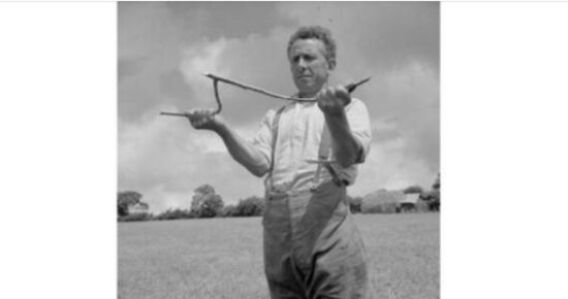Throughout history, many tools once essential for everyday life have become almost forgotten as technology has advanced. Some of these tools, now considered antiques, spark curiosity when discovered in old barns, attics, or passed down through generations. One such tool, which has resurfaced in online communities, has left many people baffled. If you’ve come across a photo of a peculiar V-shaped object, you may have wondered what it was used for. The answer is fascinating, and it dates back centuries.
At first glance, this object may appear to be nothing more than a simple, old tree branch. However, it is far from ordinary. In fact, it holds a significant place in history, going all the way back to the 1500s. This seemingly simple object is known as a “divining rod” or “dowsing rod,” and it was used in a practice called “Water Dowsing.”
Water dowsing, or divining, is the art of using a tool, like the V-shaped rod, to locate underground water. While this practice might seem superstitious by today’s standards, it was a critical skill for people living in rural areas where access to water was crucial for survival. In a time before modern plumbing and water systems, finding a reliable water source was a matter of life and death. The dowsing rod was a vital tool for this task.
The process of water dowsing involved holding the two branches of the rod in each hand, with the palms facing upward. The user would then walk around, allowing the stem of the V to tilt toward the Earth. When the rod reacted by vibrating or moving, it was believed to signal the presence of water beneath the surface. This method was so widely accepted that people even referred to practitioners of dowsing as “diviners” or “well witches.”
While the concept of water dowsing may sound like folklore, the practice was so common that even metal rods were used in later years to find not just water but also metals hidden underground. By the 1500s, dowsing became a trusted method for homeowners and landowners in rural areas to find the resources they needed to thrive. The practice has persisted into modern times, though it has largely fallen out of favor as scientific understanding of geology and modern technology have provided more accurate ways to locate water.
The belief in the effectiveness of water dowsing, however, remains a topic of debate. Some claim that dowsers have a natural sensitivity to the Earth’s electromagnetic fields or other forces that help them detect underground water. Others view it as nothing more than a pseudoscience, with no real evidence to support its accuracy. Nevertheless, for centuries, dowsers played an important role in their communities, providing a valuable service to those in need of water.
The revival of interest in these antique tools, such as the dowsing rod, can be attributed to our fascination with history and nostalgia. In an age where modern technology dominates our lives, there’s something captivating about looking back at how our ancestors lived and the tools they relied on. The simplicity of the dowsing rod, combined with its mysterious nature, makes it a topic of intrigue for many today.
Some people are even reviving the practice of dowsing as a hobby or a way to connect with nature. Although it’s largely dismissed by modern science, those who practice dowsing today often see it as a form of meditation or spiritual connection with the Earth. For them, the rod is more than just a tool; it’s a way to engage with the world in a meaningful, mindful way.
If you’ve ever stumbled upon an old, V-shaped branch-like object and wondered what it was used for, now you know. This tool, once an essential part of life for those seeking water, has a rich history rooted in human ingenuity and the need to survive in a world where resources were not as easily accessible as they are today.
In conclusion, the dowsing rod may no longer be a common tool, but it remains a symbol of a time when humans relied on their intuition and simple tools to meet their most basic needs. While modern science has replaced many of these old methods, the stories and traditions of tools like the dowsing rod continue to capture our imagination. Who knows—perhaps the next time you come across a forgotten tool, you’ll be one of the few who can recognize it for what it truly is.
Let us know in the comments if you’ve ever seen or used a dowsing rod, and share your thoughts on this mysterious practice.
